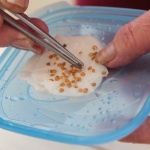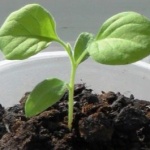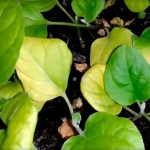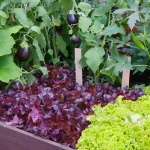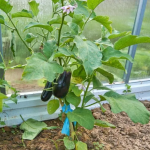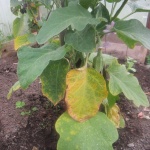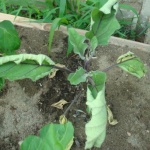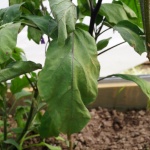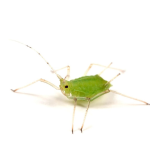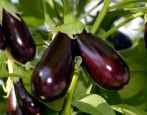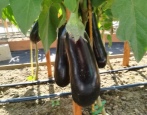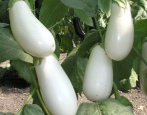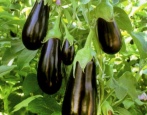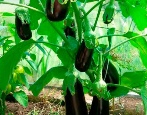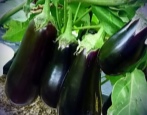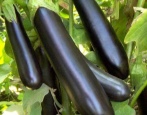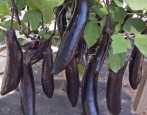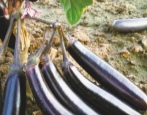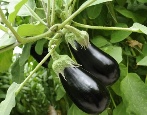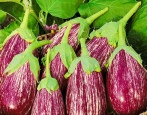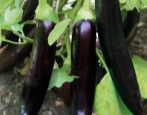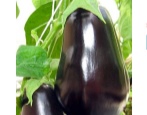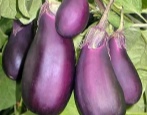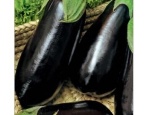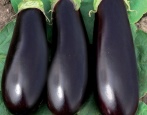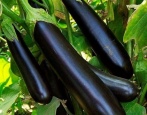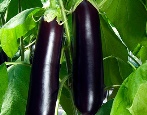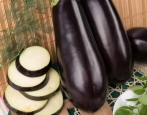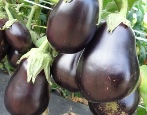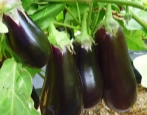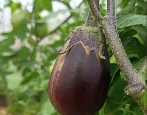
- Authors: Ognev V.V., Geraskina N.V.
- Year of approval: 2015
- Bush height, cm: up to 70
- Fruit size: medium-large
- Fruit shape: elongated-clavate
- Fruit weight, g: 200-250
- Keeping quality: about a month
- Ripening terms: mid-season
- Color of the pulp: whitish
- The period from germination to harvest: 115-120
Eggplant Khalif is an unpretentious medium-ripening culture. The plant prefers warm climatic conditions, therefore, the yield of the variety in the southern regions practically does not differ when grown in greenhouse conditions in areas of risky farming. Due to its excellent taste, a long storage period and transportation without losing its presentation, the variety is in demand both in private household plots and when grown on an industrial scale.
Description of the variety
Eggplant Khalif is the result of painstaking selection work of agricultural engineers V.V. Ognev and N.V. Geraskina.In 2015, work on breeding the variety was completed, and the resulting crop was officially registered and entered the wholesale and retail sale. The variety immediately won a leading position in the ranking of vegetable crops due to its unpretentiousness, excellent taste and versatility. The heat-loving variety demonstrates high yields both when grown in open areas and under polyethylene and polycarbonate shelters.
Advantages:
ease of care;
resistance to climate change;
lack of a bitter taste;
excellent taste indicators;
high level of keeping quality and transportability;
universal purpose.
Disadvantages:
thermophilicity;
low resistance to pests.
Characteristics of the appearance of plants and fruits
Eggplant Khalif is a medium-ripening culture. The height of the central stem of a semi-spreading bush reaches 70 cm. The glossy green deciduous mass is of medium size and slightly corrugated edges. A distinctive feature is the absence of pointed growths on the fruit calyx.
The fruits of this variety have an elongated club-like shape and a slight curvature. The length of vegetables ranges from 18 cm to 20 cm and depends on the degree of ripeness, and the diameter is often 6 cm. The color of the fruits in the phase of technical ripeness is deep purple. The leathery cover is shiny with a glossy sheen. The average weight of a ripe vegetable is 200-250 grams, and their fleshy structure is painted in a muted white shade. When growing this variety, it must be borne in mind that the harvested crop can be stored in a cool room for 30 days without loss of marketability.
Purpose and taste
The dense structure of the fruit and the absence of bitter notes make the harvested crop versatile in the preparation of culinary delights. Experienced housewives use eggplants not only for preparing seasonal dishes, but also for creating winter preserves, as well as for vegetable frosts, in which eggplants retain not only their taste, but also their vitamin composition.
Ripening terms
Eggplant Khalif belongs to the crops of the mid-early ripening of fruits. Harvesting after the appearance of the first shoots can be carried out within 115-120 days. The technical ripeness of the fruits occurs 30 days after the formation of inflorescences.Particular attention should be paid to the fact that overripe fruits lose not only their presentation, but also their taste characteristics.
Yield
Eggplants are heat-loving crops that produce the maximum amount of yield in regions with warm climatic conditions, as well as in a greenhouse environment. In the most comfortable conditions, this variety is, on average, capable of forming up to 3.6 kg of fruits on an area of 1 m2.
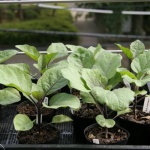
To get a tasty and bountiful eggplant crop, you must first grow strong and healthy seedlings. This culture is considered very capricious, therefore, you need to take care of seedlings when growing at home as correctly and carefully as possible.
Landing scheme
To prevent thickening of spreading green spaces, as well as to prevent the development of fungal diseases, vegetable breeders recommend that when transplanting seedlings to a permanent place of growth, it is imperative to observe the distance between the bushes. The classic planting pattern is 70 cm by 30 cm.
Growing and care
To obtain a stable and high-quality harvest, agricultural technicians recommend performing basic agrotechnical measures when growing eggplant. Despite the average ripening time of the fruits, the culture is grown by the seedling method. Sowing of prepared seed material must be carried out in the first decade of March. To obtain strong and healthy seedlings, it is necessary not only to create a comfortable microclimate, but also to prepare a nutritious soil consisting of peat, compost and garden turf. The germination of seeds can be reduced by deepening them by more than 15 mm. Diving of seedlings is carried out at the stage of formation of 2-3 true leaves.
Planting healthy and strong seedlings in a permanent place of growth should be carried out in the first decade of May, after sufficient warming up of the air masses and the passage of residual frosts. The selected area should be as illuminated as possible and protected from drafts. The age of the sprouts for transplanting must be at least 60 days, and the height of the stem must necessarily reach 25 cm.Culture care will not cause difficulties even for novice gardeners, since it consists of a set of classic activities:
timely watering, taking into account the precipitation;
regular loosening of the soil;
soil enrichment with mineral fertilizers;
protection against pests.
To prevent the trunk of the spreading bushes from breaking, the plants must be attached to the central support; if necessary, ripe fruits can also be fixed. When more than 6 ovaries are formed on one bush, it is necessary to remove all unnecessary inflorescences.
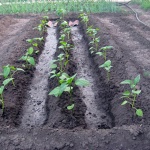
Planting eggplant is one of the most important stages in growing. When choosing a place for eggplants on your site, it is important to remember that this culture should be in warm soil, constantly illuminated by the sun. The plant is also very fond of spacious, open spaces, since its roots can grow over sufficient areas.
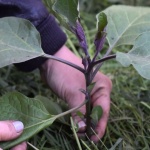
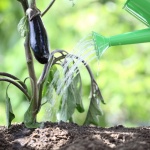
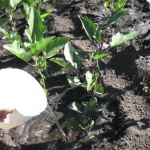
Disease and pest resistance
Before choosing and planting this type of eggplant, it is imperative to pay attention to its immune response to the most common diseases. The culture is relatively resistant to verticillium and fizariosis. However, green spaces are often affected by Colorado potato beetle and spider mite infestations. Taking into account this feature, breeders-practitioners recommend several times per season to process green spaces with special chemical and biological preparations.

Eggplant is one of the most demanding crops. For its successful cultivation, it is necessary to create optimal conditions, as well as to carry out prevention and fight against diseases and pests. Eggplant often infects both fungal and viral diseases. If treatment is not started on time, you can completely lose the crop.
